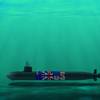Rolls-Royce gas fueled engines power five new ferries that went into service on two routes on the west coast of Norway in January 2007.
Norway is dependent on passenger/vehicle ferries to connect sections of the road network. Deep and wide fjords cut far into the country and the new ferries provide two essential connections in the E39 highway up the west coast.
Traditionally, diesel powered ferries have provided this link and the decision to use liquefied natural gas (LNG) as fuel was influenced by several factors.
Because of the mountainous and difficult nature of the terrain and the long coastline, sea transport plays a much larger part in the Norwegian economy than in most countries. Exhaust gas pollution from the maritime sector is therefore a larger proportion of the total. Moving some of this transport system to natural gas fuel will cut emissions substantially.
A second factor is that Norway is a major producer and exporter of natural gas, yet domestic consumption is small. The new ferries will provide a base load consumption which helps to justify the building out of a natural gas distribution infrastructure.
Rolls-Royce has long experience with gas fuelled engines. Its Bergen lean burn spark ignition technology was first developed more than fifteen years ago and has proved very popular for power generation on land. Engines in service burn natural gas and also other fuels such as gas derived from landfill and from fermentation of effluents. More than 420 engines are now in service in many countries.
These medium speed engines share many components with the Bergen marine diesel engine range but it is only now that gas fuelled engines are becoming popular for marine propulsion. Bergen gas engines are approved either for generator set power or for direct mechanical transmission to propellers. In the case of the Norwegian ferries, the engines are supplied as complete generator sets in a diesel electric propulsion system.
Three of the five ferries are operating on the Halhjem-Sandvikvåg route south of Bergen. The other two operate across Boknfjord near Stavanger further south. The vessels are very similar but the three on the northern route are powered for a 21 knot service speed to give the required departure frequencies and total transport capacity. The two on the southern route required a 17 knot service speed and consequently substantially less power.
Ferry operator Fjord 1 won the contract to provide the ferry service. The vessels were designed by LMG Marin and built by two of the Aker Yards shipyards in Norway. They are double ended ferries with an open vehicle deck shielded by high sides and bow visors. The passenger decks and wheelhouse are located amidships above the vehicle deck. The overall length is 128.8m with a maximum beam of 19.1m and a draught of 4.5m. A maximum of 198 cars can be carried, or alternatively a mixture of cars and other vehicles, for example 12 articulated trucks and 150 cars. Five hundred and thirty six passengers can be transported. Loading and discharge are over linkspans at the terminals. Several lanes of vehicles can be loaded simultaneously and passengers are segregated from vehicles as they board and disembark.
On the faster ferries four Rolls-Royce Bergen generator sets provide power for all purposes. There are two KVGS-16G4 sets each producing 3,535kW at 1,000rpm plus two engines of the same type, but with twelve instead of sixteen cylinders, each developing 2,650kW. A 21 knot service speed requires about 8,300kW so that the vessel can maintain schedule on three generator sets. The 17 knot ferries have two Bergen KVGS-12G4 generator sets developing together 5,300kW. The four knot difference in speed represents a large increase in power for the faster vessels but it enables the route to be served by three ferries instead of four, so the chosen solution was the most economical overall and was also not worse in terms of emissions.
Rolls-Royce gas engines produce much lower emissions than diesel engines of the same power. Using LNG as fuel cuts CO2 emissions by about 20% compared with an engine running on marine diesel and producing the same power. NOx emissions are reduced by about 90% and sulphur oxide emissions, which are important in coastal traffic, become practically zero.
The new ferries are fuelled by road tanker and the gas on board is carried in a large insulated flask. The liquefied gas is drawn off as needed, warmed to evaporate it and fed to the engines as a gas, the whole installation meeting both DnV class rules and Flag State requirements.
Rolls-Royce gas engines have also been selected for other ship types. A 7,500m³ gas carrier has been ordered by the Dutch shipowner Antony Veder. This vessel will carry a variety of liquefied gases and is to have a hybrid propulsion system. When LNG is available as fuel it will run on its Bergen gas engines. There may be occasions when gas is not available and it is also equipped with a Bergen diesel engine.
Applications of Rolls-Royce gas fuelled engines to date have all been as generator sets for electric transmission to the propulsion system. However, the gas fuelled engines can also be coupled direct to CP propellers via reduction gearboxes because the combustion system and controls can handle the rapid load changes involved with this type of system when maneuvering.
Subscribe for
Maritime Reporter E-News
Maritime Reporter E-News is the maritime industry's largest circulation and most authoritative ENews Service, delivered to your Email five times per week










